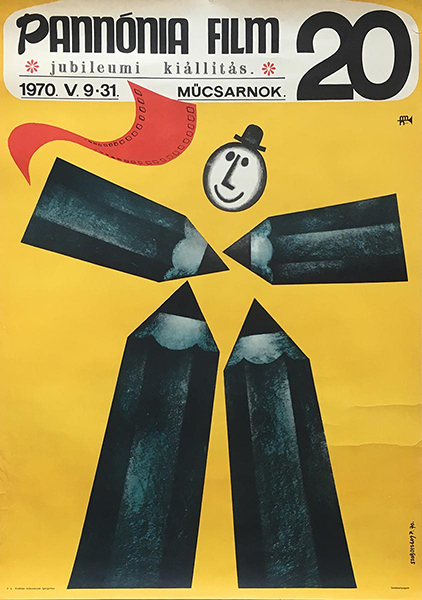
Pannónia Film Studio 20 years - Jubilee exhibition
Hungarian title:
Pannónia Film 20. - Jubileumi kiállítás
Artist:
Szoboszlay, Péter
Size:
A1 1 Sheet (cca. 84 x 59 cm)
Year:
1970
Condition:
Fine, some creasing and wear along the borders, small tears.
Material:
Paper, offset lithography.
Price: US$400
Description:
Pannonia Film Studio 20 - jubilee exhibition is a 1970 Hungarian vintage animation history exhibition poster designed by Peter Szoboszlay.
Pannonia Film Studio (also known as MAFILM Pannónia Filmstúdió) is the largest animation studio in Hungary, based in the capital of Budapest. (source: wikipedia.org)
Small genre - not a small art
The egg comes out of a flaky kneeling. It's rubbing its eyes, looking at the world, as if he were just watching TV news ... He would go back to the egg. Finished, the end of Béla Vajda's Eggs cartoon. There were two minutes, two minutes of philosophical thought: people, the new life we do not like is this uneasy world, we do it better.
Milestones, gold
A two-minute work by Benjamin Béla Vajda, the Pannónia Film Studio, also perceives the modern aspirations of our drawing and puppet art, the richness of its possibilities and expression tools. Over the course of twenty years, this genre was a great way in its form, and in its content it was renewed. The stages of this journey are presented at the Pannónia Filmstudio's jubilee exhibition in the Műcsarnok: the first Hungarian cartoon, The Half-Crane of the Little Rascal Diamond from the colorful fairy tales of the mini-movie about human and world-carrying social commentary. The Kiskakas, inspired by folk songs, made a one and a half year work in Gyula Macskássy's studio. He was a sweet boy, Walt Disney, designed to fit his cartoon taste: he also won a prize at the Paris Children's Film Festival. The other film of the "heroine", The Two Pepper Buttercup, won first prize in Warsaw. From the Kiskakast to the Eggs, the Pair and the Koncertissimó, their awards show the worldwide success of the Hungarian animation (drawing and puppet). The Venetian Golden Lion Award. the Karlovy Vary, Cannes, Oberhausen, Trieste, Chicago awards, the Krakow Golden Dragon, the Leipzig Golden Pigeon, the New York Blue Ribbon, the French Grand Prix of Filming Days, the Aranyduke of Mannheim ... - past decades of trophies. It is no coincidence that international success, the loving "goldsmith", has been accompanying our twenty-year drawing and babe films for almost ten years. The "genre revolution" of the 1960s gave impetus to the stepfather of the feature-making filmmaking industry to become an adult genre. The traditional representation of Walt Disney was no longer suitable for expressing truly modern, human behavior and social processes: a new form of language developed with modern expression tools and bolder graphics. Young filmmakers - most of them won the festival prize - almost all of Gyula Macskássy's disciples. Interestingly, however, they are in different styles. Many people regret that there is no characteristic Hungarian cartoon school. Perhaps it is rather gratifying that young people have retained their individuality, their own vision and representation. György Kovás and Dezső Komiss's paintings with fine art elements, photographs of Sándor Reisenbüchler (artwork with photo). With András Cseh's paper-cut films and the rest of the individual styling work we would have had a poorer cartoon style.
Poetry, humor, philosophy
Animation (that is, called drawing and puppet production) means; give souls to drawings, puppets, to bring them to life. The puppet-style Ottó Foky gives the character a touch of character as well, starring the mysterious small "criminality" of my vitamins: boxing gloves, flashlights, tools. And they live, we're excited about them! Attila József's poem translated into Hungarian cartoons in Zsolt Richly, in India, five Hungarian folk songs for his "cartoon" celluloid band in Suvit, his latest work being Páva, inspired by Ady verse, Kodály's choral work. Sándor Reisenbüchler expressed 15,000 drawings of the movement of the stars in the abduction of the Sun and the Moon. The film prize won at the Miskolc Festival was made by Ferenc Juhász's folk tales. The little cartoon can be married, like the satirical Bridge of Marcell Jankovics, or Béla Vajda's two-minute skeleton stripping stripe. To be astonished as Bélai-Gémes's Concert Hall. in which uniformed musicians, machine gun and cannon instruments are waiting for the conductor's intent, and the audience - humanity assists him. At other times, the cartoons such as Mézgáék and Gusztáv are family fun or entertaining, like Tamás Sipos Tamás explaining the mechanics of the cartoon, which will continue to be entitled I will explain the future
One evening with Gusztáv
Hundreds of films are being made this year in Pannonia. Among them are the twenty-eight part La Fontaine series in French co-production, Attila Dargay. The Academy of Wife Education teaches István Szomaházy's book to cartoon Béla Vajda and István Hegedűs. The Dargay - Sajdik composer is a half-hour, funny drawing film that works on the scenario of the Trojan War. After the sixty-eight great episodes, the Gusztáv movie is being screened for the whole evening, and a new series of Mézga, the main character of which is the family's wit, Aladár's "lüke". The majority of the studio's production - and perhaps the benefit - are still provided by minisatirs, microdramas, walnut-film crevices. These three-five-minute movies deserve much more attention (and much less) in a medium-quality feature film. In fact, only the spotlight of the festival sparkles has highlighted some excellent works: this is the filmpropaganda and partly the debt of criticism. But the value of the film is not measured in meters, and the cultivation of small genres is high, it is not a small art. Twenty-Five is the Hungarian film crew. Adult - in all respects.
Written by Vera Vajk
(source: arcanum.hu, Népszava, 1970-05-20 / 116)











